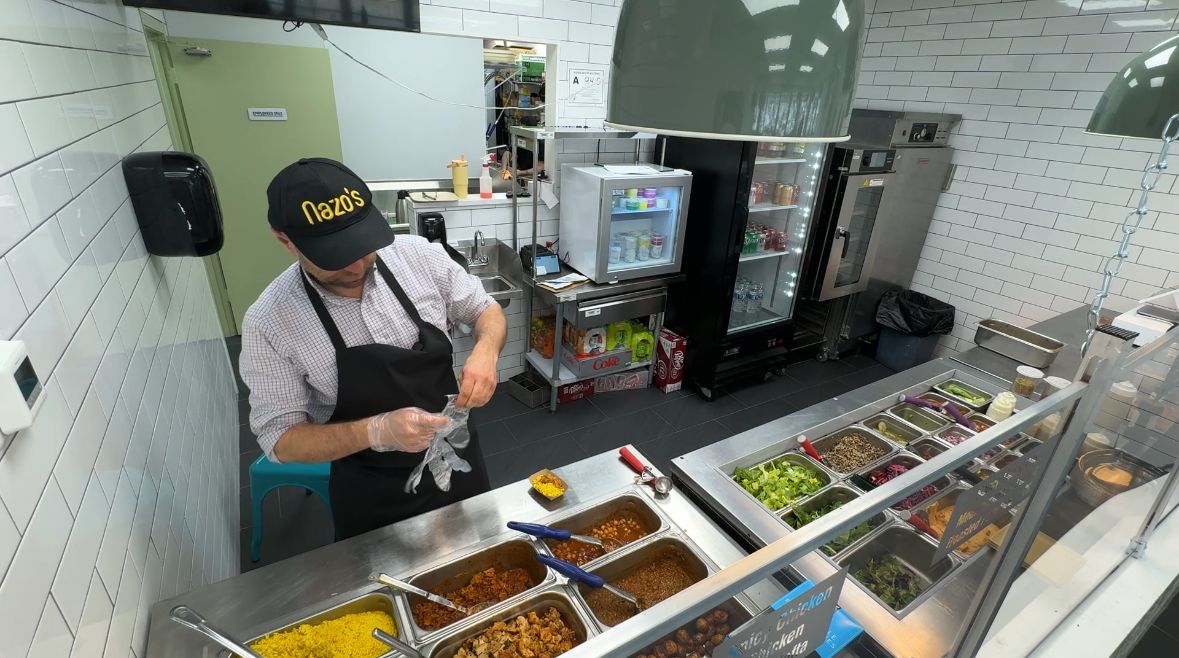CHARLOTTE, N.C. — The floors are a clean, flat white. The halls smell sterile like a hospital. Muffled voices and chatter over deputies' radios fill the room.
This is the Mecklenburg County Detention Center. Behind some of these doors are people being held for Customs and Immigration Enforcement.
Mecklenburg County Sheriff Garry Mcfadden, who is in charge of the jail, claims ICE has not been easy to work with as deportations ramp up.
But if you ask an ICE agent, they say the exact opposite.
Spectrum News 1 got an exclusive look inside the jail to see how they're handling undocumented immigrant cases as tensions between ICE and the sheriff's office grow.
Spectrum News 1 followed Corporal Venant through the steps of booking people into the jail. Venant asked that his first name not be used for safety reasons.
It begins with a search inside of a red box laid out on the jail's floor.
Inmates are asked to put their hands on the walls, as the deputies search pockets for weapons or other paraphernalia.
After a search and medical exam, regardless of their residential status, all inmates are asked a series of questions.
Venant read off those questions: "Do you identify as one of the following: gay, lesbian, bisexual, transgender, intersex?"
Fingerprinting is also required. While it's routine, it's crucial in detainer cases.
Those scans link to an immigration data base, and ICE automatically receives prints of those taken into custody.
"After they complete the fingerprint photograph portion, then they will sit and wait on a magistrate to assess the charges," Venant said. "They will assess a detainer based on their charges, if it fits within the criteria to issue the detainer, they will do that.”
A detainer is essentially ICE requesting that the jail hold the person for 48 hours so immigration officials can pick them up. It is not a requirement.
Orange and purple jumpsuits, stalls and a glass divider that separated inmates from workers who file inventory and hand out jumpsuits. This was part of the next step of Venant's tour.
"So once we enter this process, everybody will get dressed. They will get we will get their property, property will be itemized by some staff, we'll give them a clean jumpsuit. They'll go inside the stall, and they'll change into their jumpsuit. Once they're finished with everything, then at that point we'll take them to their housing, and after we drop them off in their housing unit, then that's the end of the process," Venant explained.
What happens next is what has Mcfadden frustrated.
The sheriff claims that ICE isn’t picking up all those detained people within the 48 hours, leading him to release them.
He points to House Bill 10 as the reasoning behind the release.
Sheriff Mcfadden also argues that holding them longer would mean a bigger burden on his department.
Spectrum News 1 asked ICE about that.
"He's not honoring the detainer because the detainer asks for notification, and so he's not complying with that. I think I know what he says is that he's complying with HB 10, unfortunately, does not specify that they must notify us. We're hoping, you know, that that language will be changed," said Marie Somers, chief of staff for ICE's Atlanta Field Office.
Midway through the tour, our cameras were shut off. Sheriff Mcfadden asked for them to be cut because we were given direct access to the floors where immigrants are currently housed.
It looked similar to the other floors and the sterile smell followed.
At the end of the tour, Sheriff Mcfadden shared his true feelings about ICE.
"Number one, it is costing taxpayers in each county money. ICE and Homeland Security is not paying for any of this time of the 48-hour hold. So Mecklenburg County residents are footing this bill," said Sheriff Mcfadden.
Mcfadden claims that’s about $200 per day per inmate.
"At the end of the day, I don't know what the cost does," ICE's Somers said. "Sorry, the cost is for him. But in reality, if he's honoring the detainer, we're going to pick up the person within 48 hours."
Mcfadden had his own response.
“We are partners, whether they believe it or not, they need Mecklenburg County Detention Center. They need my deputies, they need our resources. So we can't imagine why they won't come and say, 'let's sit down. We want to use your facility. We want housing in your facility. We're going to call you, and we're going to talk to you.' But we haven't gotten that,” the sheriff said.
Mcfadden said another concern is repeat offenders. When released after 48 hours, there’s a chance they could be re-arrested.
ICE claims there are 18 or more people with detainers at large right now because they were released from Mecklenburg County's jail.
The sheriff's office gave Spectrum News 1 email exchanges showing the county's conversations with ICE.
Between March 18 and 20, the sheriff's office reached out four different times, the emails show. Three out of four recent attempts were met with silence, according to the sheriff's office.
Spectrum News 1 asked if there was any communication before the March date. The sheriff's office said they hoped ICE would cooperate and did not reach out.
As of Monday March 31, Mecklenburg County was 166 people on detainers. Mcfadden said that number is fluid and changes daily.











